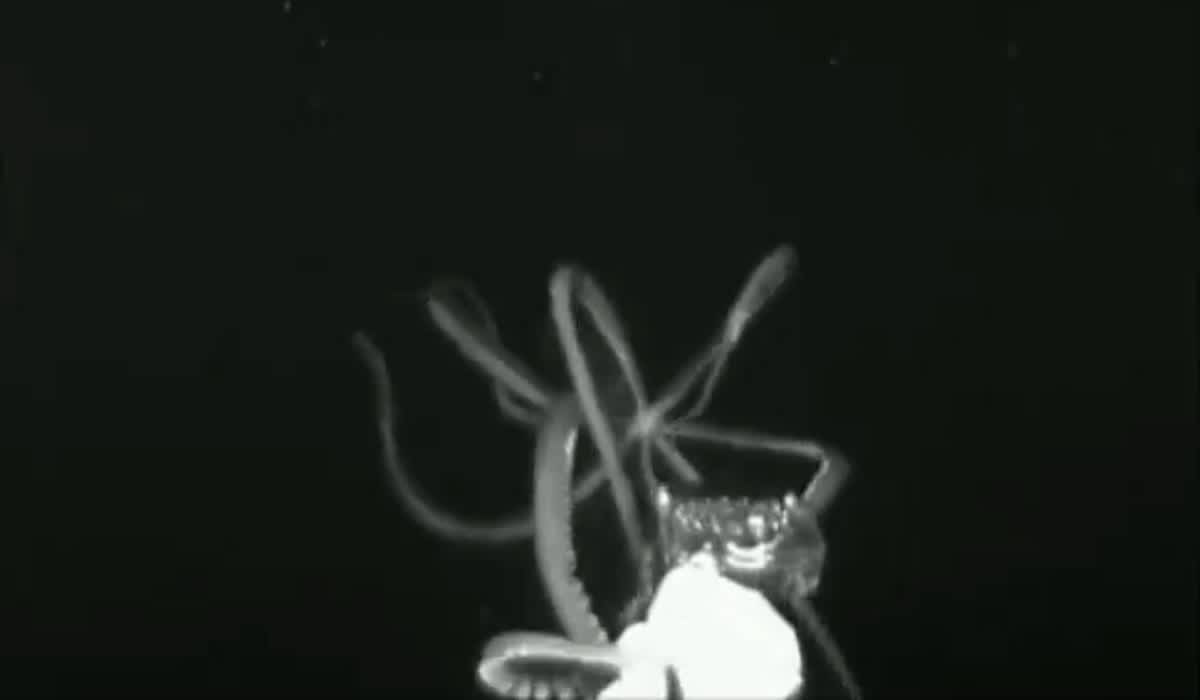Eerie Video Shows Giant Squid Caught on Camera in U.S. Waters for First Time
OutdoorHub Reporters 06.24.19

The footage has been labeled ‘haunting,’ but here’s why video of a giant squid in the deep sea has scientists all giddy.
In this short clip, which only lasts around 30 seconds and was captured roughly 100 miles southeast of New Orleans, what initially looks like a lone tentacle creeps out of the darkness in eerie fashion.
Then, the tentacle suddenly expands, revealing a deep-sea creature never before seen in U.S. waters.
“What were once monsters to be feared are now curious and magnificent creatures that delight,” the team of researchers wrote in a mission log after reviewing the video Wednesday.
“What were once monsters to be feared are now curious and magnificent creatures that delight. We like to feel that science and exploration has brought about this change.”
Read the story of how scientists captured a giant squid on video: https://t.co/RUu2YkCDFS pic.twitter.com/J2ERl10blz
— NOAA Research (@NOAAResearch) June 21, 2019
The research team says it’s the first record of a giant squid spotted in U.S. waters, and Edie Widder, a leader for the team, reportedly told the Washington Post it was “one of the more amazing days at sea I’ve ever had.”
The group of researchers were on a mission to observe marine creatures in the “midnight-zone” – around 3,280 feet below the ocean’s surface – at the time of their mind boggling discovery.
Using a special camera dubbed “Medusa,” the team’s overall goal was to try and better understand how deep sea critter’s vision is affected at great depths. The Medusa uses red lights that are invisible to most creatures at those depths, and has no noise-generating thrusters, so it can act as a stealthy observer of light and life even in the darkest pits of the twilight zone.
“To attract animals into the field of view of its camera, the Medusa will use either bait attached to a bar mounted directly in front of the camera or an optical lure similar to that used during the giant squid expedition. The optical lure is also known as the electronic jellyfish (e-jelly) because it was designed to imitate the bioluminescent display of the common deep-sea jellyfish.”
After some initial speculation around the animal’s size, the scientists soon came to the conclusion this was a juvenile giant squid that made an appearance on their hi-tech camera.
And even though the research team was caught in a severe thunderstorm, they were able to send the video to Michael Vecchione, a zooologist at the NOAA National Marine Fisheries Services, who confirmed the animal’s identity.
“We all proceeded to go slightly nuts,” Widder told CNN. “We know so little about how these animals survive in the depths.. this helps us learn something more about how they hunt and their energy budget, but we need to know a lot more.”
Just for reference sake, and to demonstrate how rare these encounters are, it wasn’t until 2012 that scientists first filmed a giant squid. According to Smithsonian, the largest ever giant squid recorded by scientists reached nearly 43 feet in length!
“Most importantly, we did not find a monster,” the team reiterated. “The giant squid is large and certainly unusual from our human perspective, but if the video shows anything of the animal’s character, it shows an animal surprised by its mistake, backing off after striking at something that at first must have seemed appealing but was obviously not food.”

